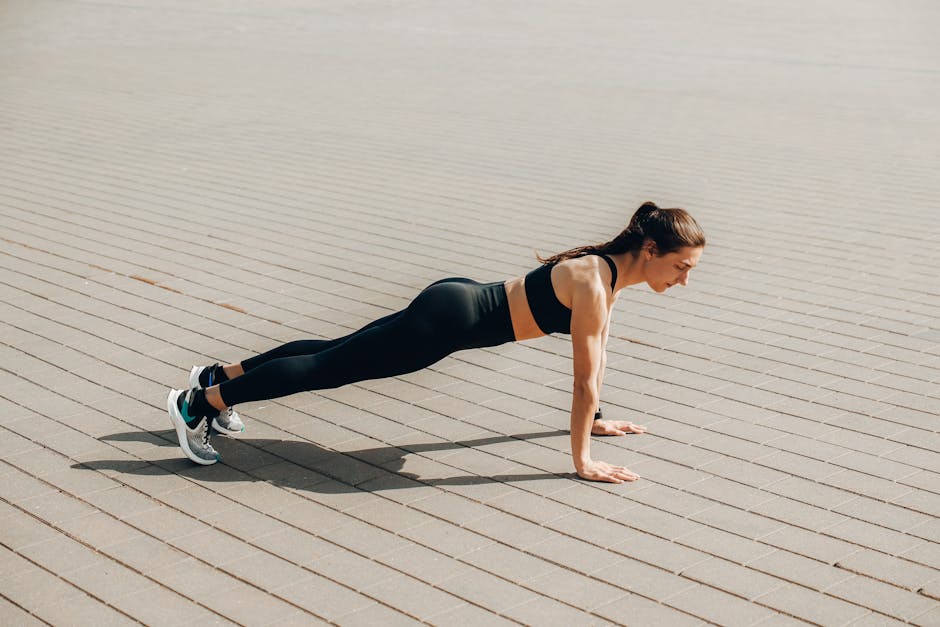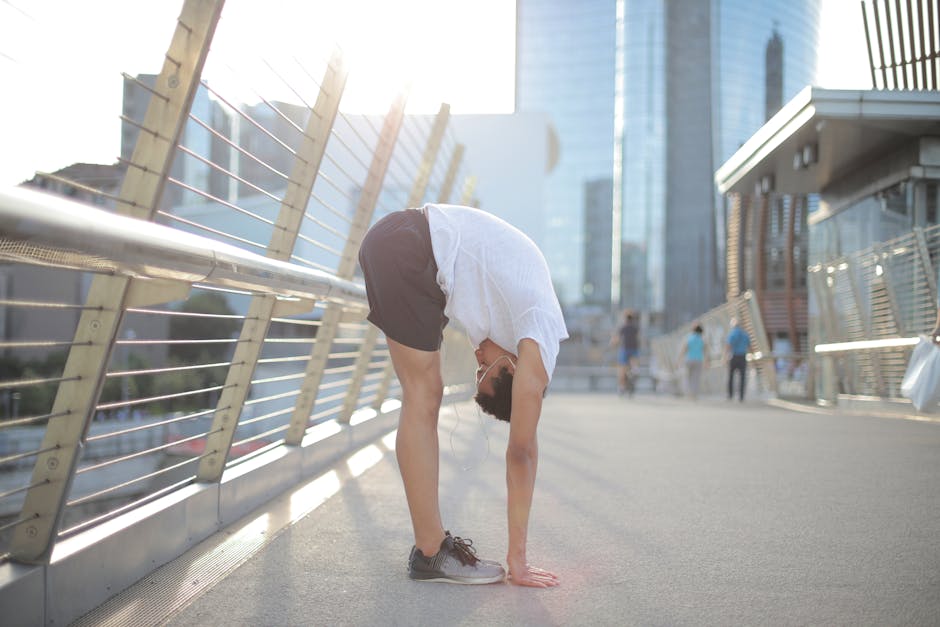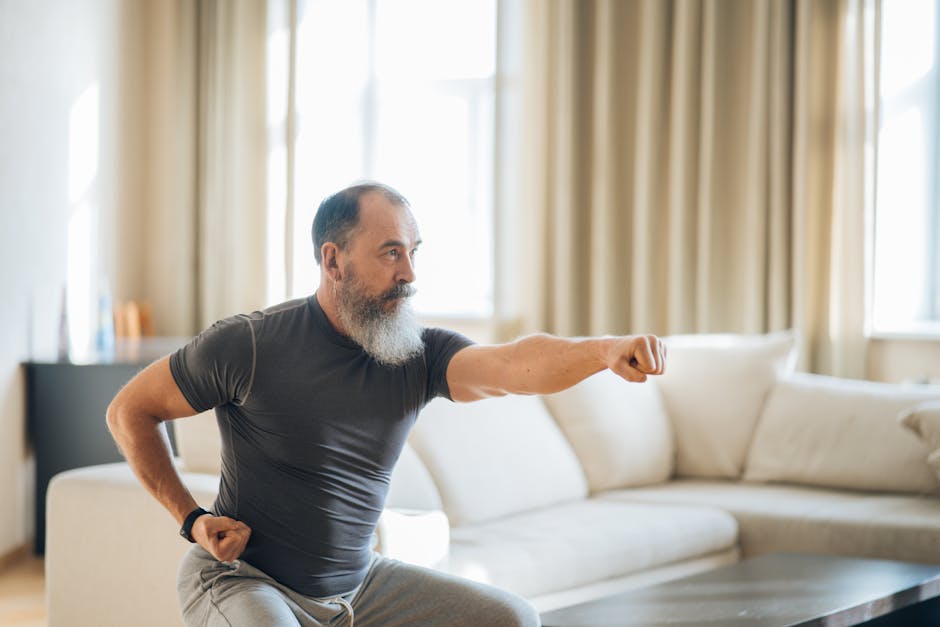How is Fitness Age Calculated?
Published by Rich Fawthrop in Fitness the 19/07/2023 at 23:18

Welcome to another informative post on The Fit Option blog! In today's article, we will explore an often overlooked aspect of our health and fitness journey - our fitness age. While your chronological age is a measure of the number of years you have been alive, your fitness age takes into account various physical factors to determine how well your body is functioning relative to your age group. Understanding your fitness age can help identify areas for improvement and motivate you to make positive changes in your lifestyle.
In recent years, there has been a growing emphasis on the importance of overall fitness rather than simply focusing on one's appearance or weight. This shift in mindset recognises that being fit encompasses factors such as cardiovascular health, muscular strength, flexibility, and endurance. Our fitness age is an assessment of these components, providing us with insights into our body's abilities and potential.
Determining your fitness age typically involves assessing certain measurements and conducting various exercises that evaluate different aspects of your physical fitness. Factors such as resting heart rate, waist circumference, and aerobic capacity are taken into consideration, along with other markers that indicate overall health and fitness levels. By analysing these metrics, an estimation of your fitness age can be calculated, providing a benchmark against which you can track your progress over time.
Knowing your fitness age can be an eye-opening experience, as it may not always align with your chronological age. It is not uncommon for individuals in their 40s to have a fitness age of someone in their 60s or vice versa. Such discrepancies can indicate potential health risks or areas where improvements are needed. However, it's important not to perceive fitness age as a form of judgment or comparison; rather, it serves as an empowering tool to motivate individuals to adopt healthier habits and improve their overall fitness.
In the upcoming sections of this blog post, we will delve deeper into the significance of fitness age, the factors that influence it, and practical suggestions on how to work towards a younger fitness age.
Define what Fitness Age is and why it is important

Fitness age is a term that measures your physical fitness level relative to your chronological age. It provides a more accurate assessment of the state of your overall health and helps you understand how well your body is functioning. While chronological age only indicates the number of years you have lived, fitness age takes into account factors such as cardiorespiratory fitness, body composition, muscle strength, and flexibility.
Understanding your fitness age is important as it helps you gauge your current physical condition and set realistic goals for improvement. It provides a comprehensive picture of your health and acts as a benchmark for tracking your progress over time. By knowing your fitness age, you can make informed decisions about your exercise routine, lifestyle choices, and overall well-being.
Moreover, fitness age is crucial for identifying potential risks and preventing future health issues . It can serve as an early warning system, alerting you to any deficiencies or weaknesses in your body, allowing you to take proactive measures to address them. By improving your fitness age, you can reduce the likelihood of developing chronic conditions such as heart disease, obesity, and diabetes.
Being aware of your fitness age can also motivate you to make positive changes in your lifestyle. It provides a tangible goal to work towards and serves as a reminder that age is not a limitation when it comes to taking care of your body. Regardless of your chronological age, improving your fitness age is always attainable, and with the right approach, you can achieve a higher level of physical fitness and overall well-being.
In conclusion, fitness age is a valuable metric to measure and monitor your current level of physical fitness. It goes beyond your chronological age and provides a more accurate assessment of your health and well-being. By understanding your fitness age, you can set realistic goals, identify potential risks, and take proactive steps towards improving your overall fitness. Embrace the concept of fitness age and unlock your body's true potential.
Importance of knowing your Fitness Age

Have you ever wondered if your biological age matches your actual age? While your birthday may tell you how many years you've been on this planet, your fitness age can tell you how well your body is functioning in comparison to others of the same age. Determining your fitness age is crucial for understanding your overall health and adopting the necessary lifestyle changes to improve it.
The importance of knowing your fitness age cannot be overstated. It provides valuable insights into your current physical condition and potential risks you may face in the future. By assessing factors such as cardiovascular fitness, strength, flexibility, and body composition, you can gain a profound understanding of your body's functionality.
Knowing your fitness age empowers you to take control of your health and well-being. If, for example, you discover that your fitness age is higher than your chronological age, it may indicate a higher risk of chronic diseases, reduced energy levels , and diminished overall vitality. Armed with this knowledge, you can make informed decisions to prioritise fitness and adopt healthier lifestyle choices .
Additionally, determining your fitness age can be a great motivator for improving your overall health and physical performance. When you realise that you are aging faster than you should, it can serve as a wakeup call to make positive changes in your habits and routines. You can set realistic goals for yourself, work on improving your cardiovascular fitness, strength, and flexibility, and track your progress over time.
Furthermore, knowing your fitness age can help you better understand the effectiveness of your fitness routine. If you consistently work out and live a healthy lifestyle, your fitness age should match or even be lower than your chronological age. On the other hand, if you have been neglecting your fitness and engaging in unhealthy habits, your fitness age may be higher, indicating the need for immediate action.
In conclusion, understanding your fitness age is an essential step towards maintaining your overall health and well-being. It provides valuable insights into your body's functionality, potential health risks, and serves as a powerful motivator for embracing a healthier lifestyle. So, make it a priority to determine your fitness age and take the necessary steps to improve it. Remember, it's never too late to start living a healthier and more active life.
Step-by-step guide to calculating your Fitness Age

Step-by-step guide to calculating your Fitness Age:
1. Assess your resting heart rate: Begin by finding your resting heart rate, which is the number of times your heart beats per minute when you are at rest. To get an accurate measurement, make sure you are relaxed and haven't engaged in any physical activity for at least 10 to 15 minutes. Place two fingers on your wrist or neck, count the number of beats you feel in one minute, and record the value.
2. Measure your waist circumference: Next, measure your waist circumference using a measuring tape. Stand up straight and wrap the tape around your waist, just above your hip bones. Make sure the tape is snug but not too tight, and note down the measurement in inches or centimetres.
3. Perform a cardiovascular fitness test: To determine your cardiovascular fitness level, you can perform a simple test like a 1-mile walk/run or a 3-minute step test. Choose an activity that suits your fitness level and complete it while keeping track of the time it takes to finish. Make sure to record the distance covered or number of steps taken.
4. Consider your physical activity level: Assess your regular physical activity level, both at work and during leisure time. Take into account the duration and intensity of your workouts, as well as any physical activities you engage in throughout the day. This can include walking, cycling, swimming, or any other form of exercise or movement.
5. Use an online Fitness Age calculator: Once you have gathered all the necessary information, you can use an online Fitness Age calculator to determine your fitness age. These calculators use various algorithms that consider factors such as resting heart rate, waist circumference, cardiovascular fitness, and physical activity level to estimate your fitness age compared to your chronological age.
6. Evaluate your results: After inputting your information into the calculator, you will receive your fitness age score. It will indicate whether your fitness age is younger, older, or equal to your chronological age. If you find that your fitness age is higher than your actual age, it indicates that you may need to focus on improving your fitness level and adopting a healthier lifestyle.
Remember that your fitness age is not static and can be improved through regular exercise and healthy lifestyle choices. By understanding your fitness age, you can set realistic goals and tailor your workouts to improve your overall fitness and reduce the risk of age-related health issues.
Key factors considered in determining Fitness Age

Age is not always an accurate indicator of one's physical fitness. In fact, scientists have developed a concept called "fitness age" to assess an individual's overall health and fitness level. This measure takes into account various key factors that can provide a more accurate representation of your physical condition.
1. Resting Heart Rate: Your resting heart rate is the number of times your heart beats per minute when you're at complete rest. A lower resting heart rate generally indicates better cardiovascular fitness and a younger fitness age.
2. VO2 Max: VO2 max is the maximum amount of oxygen your body can utilise during intense exercise. This measure is a strong predictor of cardiovascular health and aerobic endurance. Higher levels of VO2 max are associated with a younger fitness age.
3. Waist Circumference: Excess fat around the waist is commonly associated with an increased risk of various health conditions, including heart disease and diabetes. A smaller waist circumference is generally indicative of better overall health and a lower fitness age.
4. Strength and Muscle Mass: Maintaining good muscle mass and strength is crucial for overall fitness and functionality. Poor muscle strength and limited muscle mass can contribute to an older fitness age.
5. Flexibility: Flexibility refers to the range of motion of your joints and muscles. Good flexibility allows for proper movement and reduces the risk of injuries. Individuals with greater flexibility tend to have a lower fitness age.
By considering these key factors, scientists can estimate an individual's fitness age, which may differ from their chronological age. Understanding your fitness age can provide motivation to improve or maintain your fitness level, leading to better overall health and longevity.
Methods and tools for measuring Fitness Age
Measuring your fitness age is a great way to assess your overall health and track your progress towards fitness goals . By determining your fitness age, you can identify areas that need improvement and tailor your workout routine accordingly. Here are some important methods and tools commonly used to measure fitness age:
1. VO2 Max Testing: One of the most accurate methods to determine fitness age is through a VO2 max test. This test measures the maximum amount of oxygen your body can utilize during intense exercise. A higher VO2 max indicates a more efficient cardiovascular system, which reflects a younger fitness age.
2. Heart Rate Monitoring: Monitoring your heart rate during exercise can provide valuable insights into your fitness age. By measuring your resting heart rate and heart rate recovery, you can assess your cardiovascular fitness level. Using a heart rate monitor or fitness wearable can help you track and analyze this data accurately.
3. Physical Fitness Assessments: Various physical fitness assessments, such as the Cooper Test or the Rockport Walk Test, can gauge your cardiovascular endurance. These assessments typically involve measures like walking , running, or cycling a specific distance within a specific time frame, providing an indication of your fitness age based on performance.
4. Body Composition Analysis: Your body composition, including the amount of muscle mass and body fat, plays a significant role in determining your fitness age. Tools like bioelectrical impedance scales or DEXA scans can provide accurate measurements of body fat percentage and muscle mass, indicating your overall fitness level.
5. Flexibility Assessments: Flexibility is crucial for overall fitness, and a lack of flexibility can lead to decreased mobility and increased risk of injuries. Assessments like the sit-and-reach test or the shoulder flexibility test can give you an idea of your flexibility level and, subsequently, your fitness age.
6. Functional Movement Screens: Functional movement screens evaluate how well your body moves and performs functional activities. By identifying any limitations or imbalances in movement patterns through tools like the Functional Movement Screen (FMS), you can address weaknesses and improve overall fitness age.
Remember, these methods and tools are designed to provide a general idea of your fitness age and should be used as a starting point for improvement. Consulting with a qualified fitness professional or a healthcare provider can help you interpret the results and create a personalised plan to enhance your fitness age and overall well-being.
Explaining the Fitness Age calculator and its accuracy

Through advancements in science and technology, we now have access to various tools and resources that can help us better understand our level of fitness. One such tool is the Fitness Age calculator, which has gained considerable popularity in recent years. This calculator provides us with an estimate of our fitness age, indicating how well our body functions relative to our chronological age.
Accuracy is a crucial factor to consider when using the Fitness Age calculator. Developed by a team of researchers, the calculator takes into account various factors such as cardiovascular fitness, body composition, age, and gender. By considering these factors, the calculator can provide a fairly accurate estimate of one's fitness age. However, it's important to note that it is still an estimate and not an exact measure.
This calculator uses your body's maximal oxygen uptake (VO2max) to determine your fitness age. VO2max is a measure of how efficiently your body utilises oxygen during exercise, which is a strong indicator of cardiovascular fitness. By comparing your VO2max with the average for your age group, the calculator can estimate your fitness age.
While the Fitness Age calculator is a valuable tool, it's essential to understand its limitations. The calculator does not take into account other aspects of fitness, such as strength, flexibility, or agility. It also does not consider individual differences in genetic makeup, lifestyle factors, or any pre-existing health conditions that may influence one's fitness age. Therefore, it is advisable to use the calculator as a general guide rather than a definitive measure of your overall fitness.
Furthermore, it's worth mentioning that the accuracy of the Fitness Age calculator can be affected by the accuracy of the data you input. Providing precise measurements of your weight, height, resting heart rate , and exercise habits will give the calculator a better chance of providing an accurate estimate. It's also important to remember that fitness age is not a fixed number and can be improved through regular exercise and a healthy lifestyle.
In conclusion, the Fitness Age calculator can be a helpful tool to gain insights into your overall fitness level. While it provides an estimate of your fitness age based on various factors, it has certain limitations and should be used as a general guide rather than a definitive measure. Ensuring the accuracy of the input data is crucial for obtaining more accurate results. By understanding its limitations and incorporating a balanced approach to fitness, you can work towards improving your fitness age and overall well-being.
Factors that can affect your Fitness Age

Factors that can affect your Fitness Age:
1. Lifestyle habits: Your daily routine and lifestyle choices greatly impact your fitness age. Regular physical activity, a balanced diet, and getting enough sleep are crucial for maintaining good health and improving your overall fitness age. Additionally, avoiding smoking and excessive alcohol consumption can also have a positive impact on your fitness age.
2. Genetics: While genetics plays a role in determining your fitness potential, it does not mean that you cannot improve upon it. Some individuals may naturally have a higher fitness age due to their genetic makeup, but with a consistent exercise regimen and healthy habits, you can still work towards improving your fitness age.
3. Body composition: Body fat percentage and muscle mass are important factors that can influence your fitness age. Higher levels of body fat and lower muscle mass can negatively impact your fitness age, as they can be indicative of a sedentary lifestyle and poor overall fitness. By focusing on strength training exercises and maintaining a healthy body weight, you can improve your body composition and subsequently, your fitness age.
4. Diet: Your diet plays a crucial role in determining your fitness age. A well-balanced diet rich in nutrients, vitamins, and minerals can provide you with the energy and fuel necessary to maintain an active lifestyle. On the other hand, a poor diet that is high in processed foods, saturated fats, and sugar can contribute to weight gain, decreased energy levels, and an overall decline in fitness age.
5. Stress levels: Chronic stress can have a detrimental effect on your overall health and fitness age. Increased stress levels can lead to poor sleep, unhealthy eating patterns, reduced motivation for exercise, and increased risk of developing various health conditions. Incorporating stress management techniques such as meditation, yoga, or engaging in hobbies can help improve your fitness age.
6. Previous injuries or health conditions: Past injuries or underlying health conditions can impact your fitness age. It's important to take proper care of any injuries and consult with healthcare professionals regarding any underlying health conditions to create a safe and effective exercise plan tailored to your needs.
7. Exercise routine: The type, intensity, and consistency of your exercise routine directly affect your fitness age. Engaging in a variety of exercises that challenge different muscle groups and cardiovascular fitness can help improve your overall fitness age. Combining strength training, aerobic exercises, and flexibility training in your workout routine can provide well-rounded fitness benefits.
8. Mental wellness: Your mental well-being and mindset can influence your fitness age. A positive mindset, motivation, and self-discipline are crucial for maintaining a consistent exercise routine and making healthy lifestyle choices. Taking care of your mental health through activities like mindfulness, self-reflection, and seeking professional help when needed can positively impact your fitness age.
Actionable tips to improve your Fitness Age

Whether you're a seasoned fitness enthusiast or just starting your wellness journey, improving your fitness age is a worthwhile goal. Your fitness age is a measure of how well your body functions compared to others of the same chronological age. Luckily, there are actionable tips you can implement to enhance your fitness age and boost your overall health and well-being.
1. Prioritise cardiovascular exercises: Engaging in regular cardiovascular exercises, such as running, swimming, or cycling, is key to improving your fitness age. Aim for at least 150 minutes of moderate-intensity aerobic activity, or 75 minutes of vigorous-intensity aerobic activity, per week. Cardiovascular exercises improve your heart and lung function, increase stamina, and boost overall endurance.
2. Incorporate strength training: Including strength training exercises in your fitness routine is crucial to improving your fitness age. Lifting weights, using resistance bands, or doing bodyweight exercises like push-ups and squats helps build muscle mass , increase bone density, and improve overall strength. Aim for two to three strength training sessions per week , focusing on different muscle groups each time.
3. Mix up your workouts: To enhance your fitness age, it's important to vary your workouts regularly. Incorporating different types of exercises, such as high-intensity interval training (HIIT), yoga, Pilates, or dance classes, challenges your body in different ways and prevents plateauing. Mixing up your workouts also helps prevent boredom and keeps you motivated to continue exercising.
4. Prioritise recovery and rest days: While consistency is essential for improving fitness age, so is rest and recovery. Allow your body time to recover between intense workouts to prevent overtraining and reduce the risk of injuries. Incorporate rest days into your routine and consider activities like stretching , foam rolling, or even taking a leisurely walk on those days.
5. Focus on nutrition: A nutritious diet plays a significant role in improving your fitness age. Incorporate a variety of fruits, vegetables, lean proteins, whole grains, and healthy fats into your meals. Stay hydrated by drinking plenty of water throughout the day. Limit processed foods, sugary snacks, and drinks, as these can hinder your progress. Proper nutrition supports your overall health, provides energy for workouts, and aids in muscle recovery.
6. Get enough quality sleep: Sleep is often underrated, but it's crucial for improving your fitness age. Aim for seven to eight hours of quality sleep per night. During sleep, your body repairs and regenerates muscles, balances hormones, and refreshes your mind. Prioritise creating a sleep routine, maintain a comfortable sleep environment, and limit screen time before bed to ensure restorative rest.
7. Monitor and track your progress: Keep track of your workouts, measurements, and fitness milestones to celebrate your progress and stay motivated. Utilise wearable fitness devices or mobile apps to monitor your heart rate, steps taken, distance covered, and calories burned. Tracking your progress allows you to set achievable goals and adjust your fitness routine as needed.
8. Seek professional guidance: If you're unsure where to start or want personalised guidance, consider consulting a certified fitness professional. They can assess your current fitness level, create a tailored workout plan, provide nutritional insights, and offer ongoing support and motivation on your fitness journey.
Improving your fitness age is a continuous process that requires dedication, consistency, and patience. Stay committed to these actionable tips, and over time, you'll notice improvements in your strength, stamina, and overall well-being.
